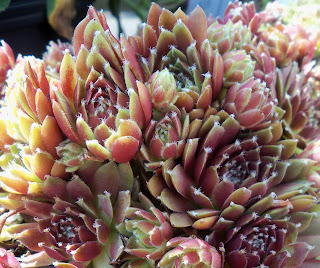Thomas’ books read like conversations with a good friend… a little disjointed, a little bitchy, very personal and totally honest. They encourage us to draw inspiration from the grandest and most fantastical of gardens, stage theatrical scenes (with plants, of course) and only plant what we absolutely love. As Thomas suggests “Non-contributors are a waste of money and space.” Why spend energy caring for a ho-hum plant just because it’s what you think you “should” be growing? Branch out (pun intended)! Your garden should reflect your personality.
 |
| Thomas started breeding his own Daylilies to capture all his favorite elements of the plant. His first introduction 'Connie Casserole' is an unusual warm and citrusy color with ruffly, crimped petals. |
the idea of haziness;
- Thomas uses ornamental grasses and more ethereal plants to create a fuzziness throughout the garden.
- Sunlight and dew
heighten the romance of the haze.
-
Thomas
often accomplishes tension with dramatic foliage in electric colors, colors
that seem slightly “off” or just on the edge of another… lime-yellow,
almost-purple red, misty blue-gray… or with sharp variegation.
 |
| Naturally-occuring technicolor! |
 |
| This Barberry and Spirea both contrast and complement one another. The emerging Spirea blossoms mirror the rosy tones of the Barberry foliage. |
 |
| 'Coral Drift' Rose in the foreground with 'Spilled Wine' Weigela and a bright chartreuse Thuja. |
- Thomas was a florist before he moved into garden design, and both his containers and the way he clusters them are stunning.
- I’m beginning to use more pots and planters out in my garden. It’s a great way to add small shrubs to some of the more established areas.
- Plus I
like that containers bring shorter shrubs closer to eye level.
- Thomas belongs to the “no bare ground” school of gardening, which is beautiful, but can make for very high maintenance.
 |
| A small, weeping Loropetalum, pinky, variegated Barberry and bronzy Physocarpus blend together in a blur of burgundy and red! |
Thomas
is up in Vancouver, and the mild climate allows him to grow so many interesting
plants. He especially likes varieties of
Coleus, Canna, ornamental grasses, Sedum,
Sempervivum and Echeveria that are barely hardy in the Pacific Northwest and would
never survive our erratic winters in Central Virginia.
It also means I probably won’t have a chance to visit his Southlands Nursery any
time soon. But Shocking Beauty and The Jewel
Box Garden continue to inspire me to push limits in my own garden.














































